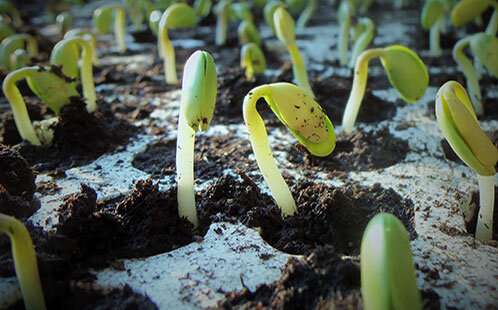From darkness to light: New findings unravel how plants control energy generation

Researchers at Western Sydney University and The Australian National University have discovered new chemical communication pathways that determine how a plant changes when it emerges from darkness in the soil to light.
When plants are grown in the dark, they are white or pale-yellow because they lack the chloroplasts that make leaves green. The yellowish color is due to structures in the cell called etioplasts that later form green chloroplasts when the seedling detects light.
Dr. Chris Cazzonelli, a senior lecturer in plant molecular biology, and his research team at the Hawkesbury Institute for the Environment have discovered a new molecular mechanism that plants use to control the transformation from yellow etioplasts to green chloroplasts. This occurs via a carotenoid-derived metabolic signal that genetically triggers the expression of genes and production of proteins controlling the formation of green pigments that harvest light energy.
"For decades, plant scientists have been trying to uncover the chemical signaling pathways in plants that govern colour, fruit nutrition, yield, and other plant performance functions. Our team has focused on investigating the functions of chemicals derived from the yellow, orange and pinkish carotenoid pigments that enrich plant fruits with a dietary source of micronutrients," said Dr. Cazzonelli.
"This discovery sheds light on an essential, novel carotenoid-derived compound that controls plastid and plant development. Much like the missing piece of a complex jigsaw puzzle, our findings reveal that yellow plastids in dark-grown plants require a specific scaffolding body to help them transition into green energy-generating chloroplasts once the plant reaches the light. These scaffolds bind carotenoid pigments and ensure that when a seedling emerges from the soil through the leaf matter, it becomes enriched in chlorophyll and ready to harvest light," co-author Dr. Xin Hou said.
Through the use of special mutant varieties of plants that make an essential carotenoid-derived signal as well as chemical inhibitors that block its production, the WSU and ANU researchers were able to demonstrate how plants make use of this signal to control the green coloration of healthy chloroplasts when exposed to light.
This finding confirms that carotenoids are more than just structural components of energy-yielding plastids—they also provide chemical signals that control how plants germinate in the dark and produce light-harvesting green chloroplasts when they reach the surface.
Professor Barry Pogson highlighted that "chloroplasts are a light energy harvesting motor of the plant and we demonstrated that carotenoids provide an important signal in control of the chloroplasts structural development."
Understanding carotenoid signaling pathways has opened up new opportunities to develop new plant functional compounds that could enhance color, nutrition, flavor, and development of plants.
The research "A cis-carotene derived apocarotenoid regulates etioplast and chloroplast development" was published in eLife.
More information: Christopher I Cazzonelli et al. A cis-carotene derived apocarotenoid regulates etioplast and chloroplast development, eLife (2020). DOI: 10.7554/eLife.45310
Journal information: eLife
Provided by Western Sydney University

















